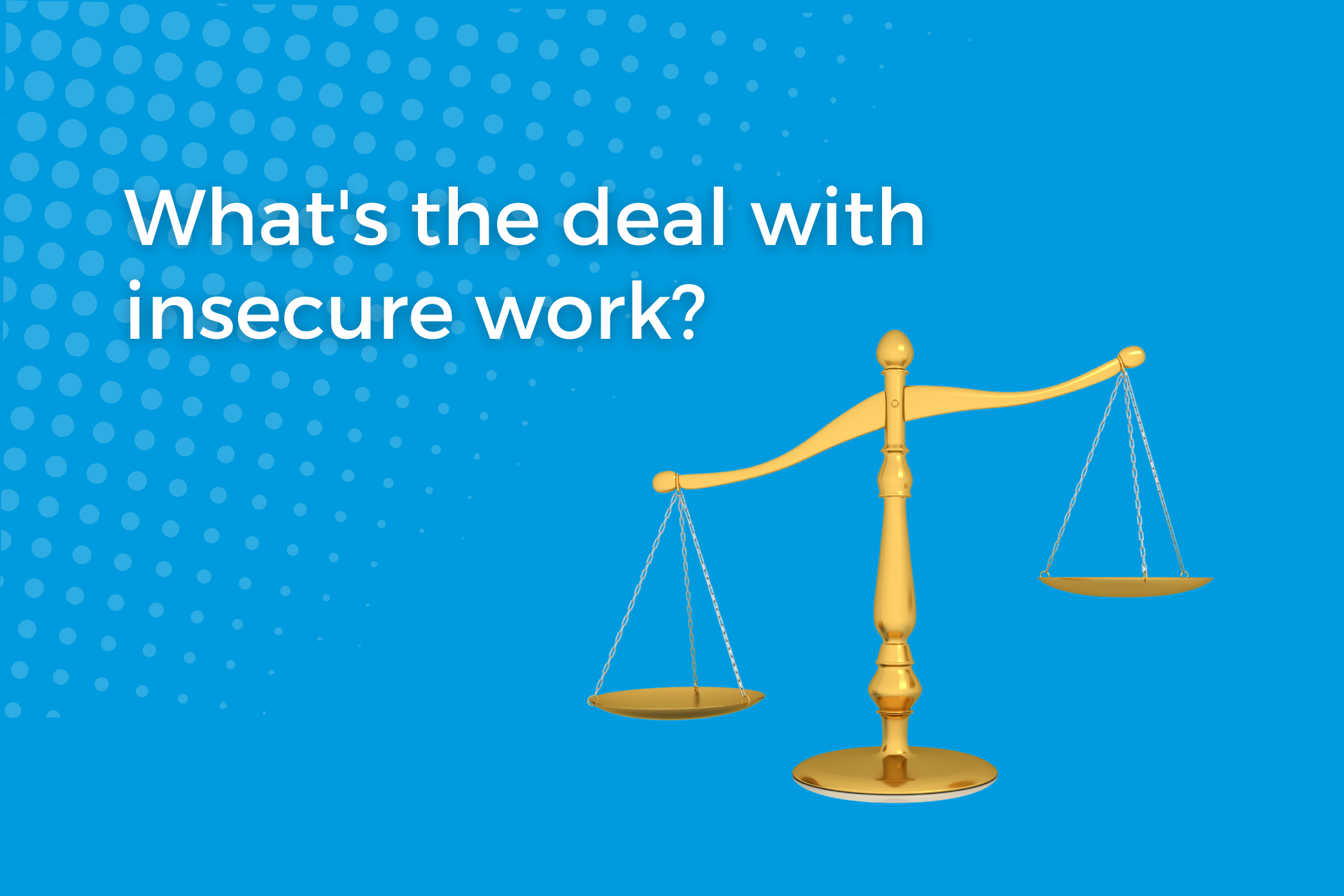
In a recent blog I implied that insecure work was a sub-optimal outcome for many workers and that it is back on the rise, in particular for workers aged 16-24.
But what exactly is insecure work? Why do firms seek it? And can it be good for workers? I explore these questions and more below, teasing out the negative aspects of insecure work which demand policy reform.
What is it?
The Health Foundation considers job security to be one of five indicators of employment which contribute to overall job quality. The other four are:
- job autonomy
- pay
- job wellbeing
- job satisfaction
The definition of job insecurity for their research is the self-reported perception that job loss is either likely or very likely in the next 12 months.
The Trade Union Council put forward that insecure work is that done on a zero hours contract (ZHC), agency, casual or seasonal work, or work done by the self-employed who earn less than minimum wage. This looks to exclude those self-employed who earn a healthy hourly wage.
But my preferred definition of insecure work is one used by the Resolution Foundation in a recent paper (see page 19):
A job where the earnings or the job itself are not predictable or guaranteed.
By this definition, an insecure job is one with unpredictability baked into the employment contract. This does include the self-employed who are happy with their lot – and why shouldn’t it? If we are to assess the impact of insecure work we must account for the positive aspects as well as the negative. The definition also does not rely on self-reported expectations of job security which may be reflective of individuals’ poor performance or economic conditions, unrelated to the nature of the work.
Why do employers offer insecure work?
Well, firms are profit-maximisers. They either want to raise revenue or decrease costs (or both). Labour costs can be fixed (eg payments to salaried workers), but they can also be variable (eg payments to temporary, hourly rate workers).
One strategy to minimise costs when needed is to increase ‘cost-elasticity’ – the change in total cost due to a change in output. Firms with higher fixed costs have lower cost-elasticity. To reduce committed labour costs, firms can outsource – i.e. procure services on a flexible basis – and use labour service providers or zero-hour contracts to increase the proportion of variable labour. This transfers the fixed costs of labour from lead firms to smaller suppliers (including the self-employed), reducing the effective wages faced by lead firms.
For example, these strategies to increase cost elasticity are used in the UK hospitality industry: firms have experience managing fluctuating demand through ‘rapid-fire recruitment and retrenchment of staff’ (see Baum, 2020) and often rely on agency workers to lower labour costs (see Lopez Andreu, Papadopolous, & Mandi, 2019). 9% of hospitality sector workers are on temporary contracts, compared to 5% of all workers in the UK (see House of Commons research briefing).
We can imagine that this sort of flexibility is even more sought after in a world with unpredictable Covid-19 surges (e.g. with variants like Omicron) that will continue to threaten revenues.
How can insecure work be good for employees?
Flexibility can be desirable for workers too.
Self-employed workers actually report higher job satisfaction (66%) than employees (55%) – see page 9 of this Resolution Foundation report – even though they earn on average less. Concerns about job security may be overridden by positive factors such as greater autonomy in choosing the tasks they do, when and how they do them. Freelancers in design, contractors in IT, and the rest of the highly-skilled, computer-based self-employed can take longer holidays and work from anywhere with a solid internet connection. 14% of the workforce are self-employed (ONS employment data).
The picture is less rosy for temporary workers (including agency workers) and zero-hour contractors, who collectively make up no more than 9% of the workforce. (ONS employment data shows us that 6% of all employees are temporary and that over 3% of all those employed are on zero-hour contracts, see ONS data set). But there are a few flexibility-related benefits for these workers:
- platform based and freelance roles often have extremely compressed application and interview processes. For anybody who has been through a lengthy job search, the simplicity of getting insecure work may be desirable.
- zero-hour contractors can decline to work a shift if it does not suit them
- the flexibility may suit those who cannot work regular 9-5 hours (e.g. single mothers, young people studying).
- if the job is not suitable, workers may not have to give notice or give much less notice than they would in a permanent position.
How can insecure work be detrimental?
Unfortunately, often the flexibility is one-sided. It provides a benefit to the employer without helping the worker. The Low Pay Commission identified three main issues stemming from unequal use of flexibility:
- income insecurity, which makes it difficult for individuals to manage their finances.
- unpredictability in working hours (e.g. changing shift patterns and short-notice cancellations) makes it difficult to take leave, or organise life around work, creating stress.
- reluctance to assert employment rights, out of fear that hours will be reduced.
Insecure workers also typically have fewer rights than other employees working for businesses across the UK. And fewer rights provide greater opportunity for labour exploitation.
- The self-employed are considered to be their own boss and are not protected by employment law. That is why bogus self-employment – where employers push staff into registering as self-employed – is extremely dangerous for the worker.
- Casual (e.g. temporary, agency) or irregular staff (eg seasonal, those on ZHCs) will often be categorised as ‘workers’ rather than ‘employees’ under employment law. They still have the right to be paid the national minimum wage, paid holiday and rest breaks. But compared to a regular employee they miss out on employment rights such as:
- Statutory Sick Pay
- statutory maternity and paternity leave and pay
- minimum notice periods if their employment will be ending
- protection against unfair dismissal
- time off for emergencies.
It is often not clear cut whether someone is a ‘worker’ or an ‘employee’. To find out more about employment status, read more here.
For workers, this lack of rights and one-sided flexibility are likely to be crucial factors in a story of dissatisfaction:
- 30% of all temporary employees state that they are working in a temporary capacity because they cannot find a permanent position (see ONS data).
- 25% of zero-hour contractors state that they want more hours compared to less than 10% of all workers (see ONS 2018 data).
- Temporary workers (16%), agency workers (17%) and ZHC workers (16%) show much higher rates of wanting a different job than full-time employees (5%) (see page 53 of this Resolution Foundation report).
Another factor is pay. Average pay is lower among atypical workers than permanent full-time employees. Partially this is to do with the fact that industries utilising these contracts pay less (e.g. hospitality where 52% of workers are low paid). But most concerningly, there is a pay penalty whereby a similarly qualified person in the same occupation will receive less if working on a temporary contract (£0.66 per hour less) or ZHC (£0.45) than if they were a full-time employee (see page 52 of the RF report).
Finally, the Health Foundation finds that those with job insecurity are likely to report worse health. Indeed, of all the different indicators of poor job quality, it seems to have the most deleterious effect.

And while some of those who are job insecure by this measure are not insecure workers (recall that the Health Foundation defines job insecurity as people who expect to lose their job within 12 months), insecure workers do face a higher risk of unemployment than permanent employees and therefore you would expect this finding to hold.
Overall, these negative aspects of insecure work – especially for temporary and ZHC workers – are likely to outweigh the benefits of flexibility, autonomy and simplicity.
What can we do?
There is good reason to think that the rising rates of temporary and ZHC work will be persistent throughout the bumpy post-covid economic recovery. The Global Financial Crisis provides precedent: insecure work ramped up from 2010 in the UK (see Resolution Foundation research from 2019). A survey I conducted with a small group of Unite the Union staff representing England, Northern Ireland and Wales, identified the post-Covid uncertainty (and the potential need to quickly lay off staff) as a driver of the increased use of agency labour, and other casual and ZHCs, in the hospitality industry.
Therefore, 2022 is an appropriate time to address the vulnerability associated with insecure work.
Government should:
- Provide Statutory Sick Pay and protection against unfair dismissal as a right to ‘workers’ as well as ‘employees’.
- Fulfil its promise to give workers on a ZHC the right to request a more stable contract; as well as providing those workers with the right to reasonable notice of shifts and shift cancellations.
- Adapt piece rates legislation to govern how app-based workers are paid the National Minimum Wage.
- Give agency workers a right to request a direct contract with the hirer.
Businesses should:
- Take the lead of DoorDash in the US and hire permanent, full-time employees in traditionally insecure gig economy roles.
- Ensure all those who do work for the company receives a statement which clearly sets out their employment status and related rights.
- Follow the Supreme Court decision in 2021 which ruled that private hire drivers (eg Uber, Bolt drivers) are workers rather than self-employed contractors, and therefore have the right to minimum wage and holiday pay.
- Undertake due diligence to ensure that any agency workers hired are being treated as workers by the agency rather than bogus self-employed.
By George Ritchie


